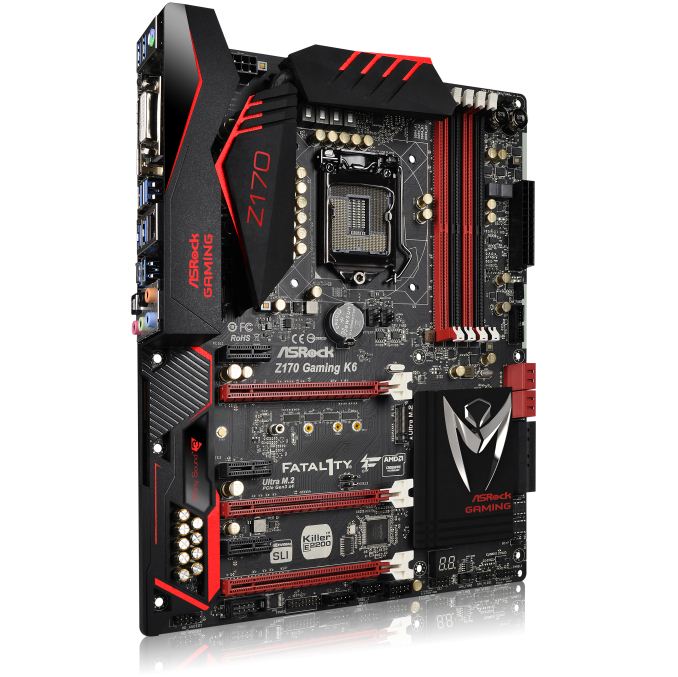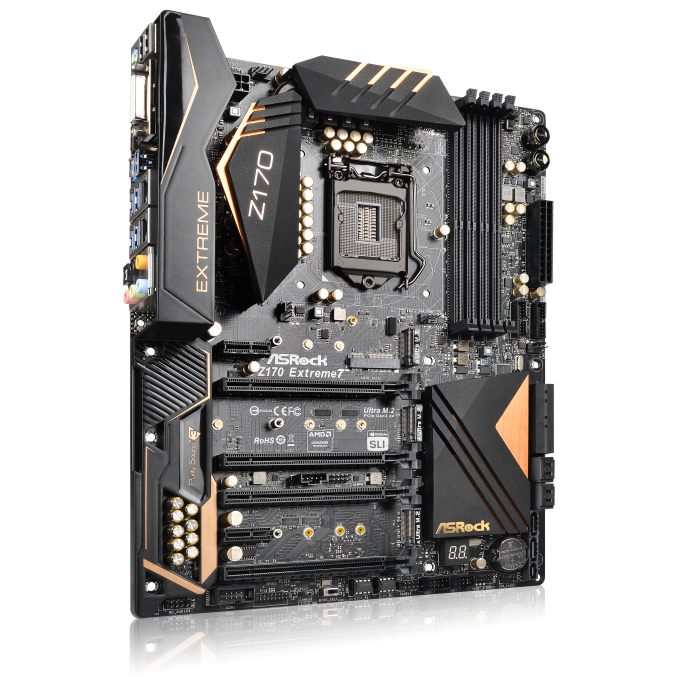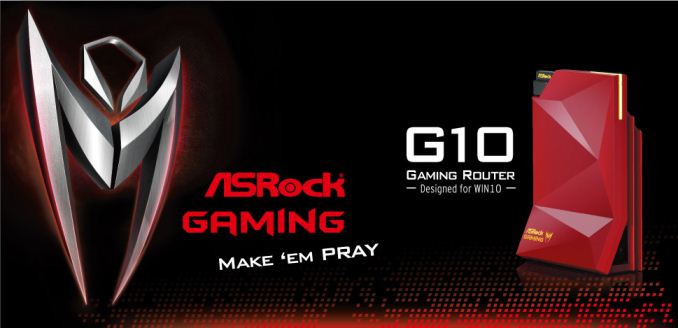ASRock at Computex 2015: Pre-Show PR gives Z170 Motherboards and 4T4R Router
by Ian Cutress on May 29, 2015 8:19 AM EST- Posted in
- Motherboards
- ASRock
- Trade Shows
- router
- M.2
- Computex 2015
- Z170
Next week is the annual Computex trade show and we have a substantial number of meetings booked, but as part of the regular pre-show ritual, companies are coming at us with the start of their press release mêlée. One of the first to officially release their embargo is ASRock, showing off some impressive equipment ready for media to gawk at when we hit the booth on the show floor.
First up is a tantalising teaser of what is to come. Anyone interested in the PC space is talking about upcoming Broadwell and the iteration after that called Skylake. Skylake for desktops will require a new chipset and new motherboard, which we at least know that Z170 is part of it (H, B and Q series motherboards are likely in the scheme as well). A big part of Computex in recent years has been showing off these designs regardless of the launch window, and ASRock’s PR today mentions two such Z170 motherboards: the Z170 Gaming K6 and the Z170 Extreme7.
The Z170 Gaming K6 throws up some interesting talking points. We have an ASRock gaming logo on the chipset, which is supposed to be akin to a praying mantis and will most likely supplant the Fatal1ty branding on the gaming range. The new socket looks similar to the one used for Z87 and Z97. The PCIe slots are split electrically x16/x8/x4 with an Ultra M.2 in the middle suggesting a PCIe 3.0 x4 M.2 slot. Killer networking returns on this platform, and it would seem that SATA Express is also along this line. In the top left, you’ll notice the DRAM slots are listed as DDR4_A1, DDR4_A2 and so on, with single sided latches supporting the DDR4 modules.
The Z170 Extreme7 images are more exciting, showing off three M.2 slots between the PCIe slots. These are all listed as Ultra M.2, which means PCIe 3.0 x4 bandwidth each for 12 lanes. At this point details of the Z170 platform have not been released, but having access to three M.2 x4 slots either means that some can only be used when integrated graphics is in play, the CPU has more than 16 lanes, or some of these are running off the chipset, none of which can be confirmed. Both the Extreme7 and the Gaming K6 would seem to have Purity Sound 3, the next iteration of the upgraded motherboard audio. This should be the Realtek ALC1150 still, however that is not confirmed as of yet.
Another surprising element to the press release was the announcement that ASRock’s Gaming brand is expanding beyond motherboards. Similar to other gaming brands from motherboard companies, ASRock will also provide mice and mousepads (no mention of keyboards or headsets), but in an interesting twist they will also provide a router. The G10 is meant to be a similarly themed (with the logo and the angled edges) device but offers 4T4R connectivity on 802.11ac. This means up to 1733 Mbps connectivity over a single WiFi application. The only critical point here is that no-one sells a 4T4R WiFi card for a PC – the most we’ve seen so far is 3T3R in commercial applications. It will be interesting to see if that leads down a certain path of better WiFi bandwidth opportunities.
We have plans to meet with ASRock during Computex where we hope to get some hands-on time with this stuff. Release dates and pricing are not being announced as of yet.
















38 Comments
View All Comments
Morawka - Friday, May 29, 2015 - link
This.... GPU's over the next year or two will be pushing PCI 3.0 Limits. Even at full 16x.We already see this in the enterprise space, where nvidia was force to make their own NV Link because PCI 3.0 was't gonna be enough for Volta
platinumjsi - Friday, May 29, 2015 - link
Not quite, the CPU still has 16 lanes but the PCH has recived a bump from 8 to 20 lanes, this is what enables the system to take 3x M.2 slots.SirKnobsworth - Friday, May 29, 2015 - link
That's not correct. The CPU still only has 16 lanes, but the chipset now has up to 20 PCIe 3.0 lanes instead of 8 PCIe 2.0 lanes. Keep in mind though that the total number of lanes (USB3+PCIe+SATA) off the chipset is limited to 28, so using all of those lanes at one usually means sacrificing something else.Morawka - Friday, May 29, 2015 - link
Wikipedia disagree's with youSirKnobsworth - Saturday, May 30, 2015 - link
I wouldn't expect Wikipedia to give accurate information about products that haven't been released yet, but I suppose given that all information is uncertain. I'm basing my information on leaked spec sheets which detail the full range of available port configurations on the PCH:http://wccftech.com/intel-skylake-s-platform-speci...
tachikaze - Friday, May 29, 2015 - link
TMK Skylake still has 16x PCIe to the CPU directly, it's the secondary connection to the PCH that has been upgraded from PCIe 2.0 8x to PCIe 3.0 20x.http://wccftech.com/intel-skylake-s-platform-speci...
The chart there also mentions Intel RST will support up to 3 M.2 slots, which would explain the 3 M.2 on the Extreme7, and also mean these M.2 would not interfere with e.g. 8/8 or 8/4/4 GPU connection (4/4/4/4 would be possible too but one 16x slot here is only single-width, alas)
Mark_gb - Friday, May 29, 2015 - link
Do not forget that Samsung now has stacked NAND. Another year or two, and they will be stacking NAND higher than a fat mans pancakes. And those little M.2 cards are going to explode in capacity, I can easily envision a 10TB M.2 card. How many of those would one need? In 10 years, if the demand is there, we could have some future version of M.2 that could have just incredible amounts of storage that is persistent. It might not be stacked NAND, but it will appear to us humans to function the same way.Many of us have read that the FIVR (power management hardware) which only recently was placed directly onto the CPU package by Intel, is going to move back to the motherboard with Skylake. Now I sit here and wonder why Intel would integrate the power on-die, and then despite the fact that it seemed to work very well, suddenly move it back to the motherboard. And then we learn about HBM. I think the real estate next to the CPU just got a whole bunch of competition for space. What if Intel eliminates or greatly reduces on-chip cache, and in its place, drops a massive 64GB HBMv2 (yes that memory AMD has invented) right next to the CPU core. Suddenly we don't need four or eight 240 pin slots on the motherboard anymore. And even without the memory slots, we would have far more memory on the CPU interposer than we have ever been allowed to drop into those 240 pin slots that just went poof! Then the next thought is "Oh man! The memory companies are going to disappear overnight!!" But users suddenly having 64 GB of extreme speed RAM with every CPU. And guess who gets to charge us for all of that memory. Yup, Intel takes over the vast majority of memory sold on the entire planet almost overnight.
This new HBM memory is going to completely change the computer industry. It will take some time, but I firmly believe that HBM will, within 5 to 7 years, replace nearly all other forms of memory. Memory will be sitting a fraction of a mm away from the processor. And there will be far more memory on most processors than there has ever been because HBM costs will be far below with single layer memory chips cost today.
romrunning - Friday, May 29, 2015 - link
SATA Express needs to die. Only M.2 and NVMe are desirable for future chipsets!meacupla - Friday, May 29, 2015 - link
I only have two issues with M.2, not that I don't think it's the proper upgrade path from SATA.One of them, is that they run slower when they get hot, and this can be a problem on mobos that place them into parts of the board that get hot air blown onto (under graphics cards) or no air at all (behind mobo)
The other is ease of cloning and upgrading SSD drives. It's pretty simple if you have at least two of the same drive connectors, but if there's only one of them, then it's extra work.
cyrand - Friday, May 29, 2015 - link
I rather see SFF-8639 then M.2 on a desktop.